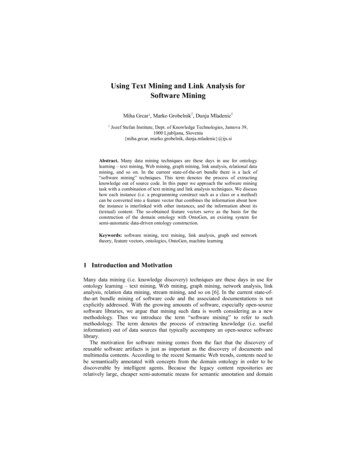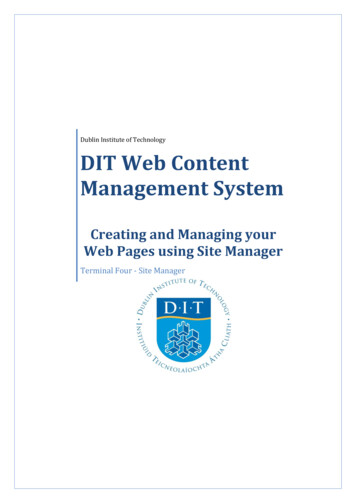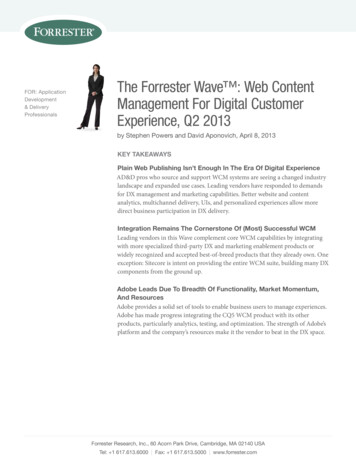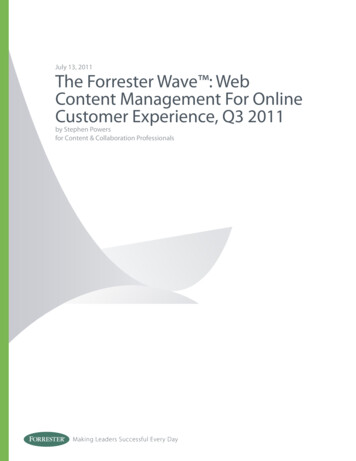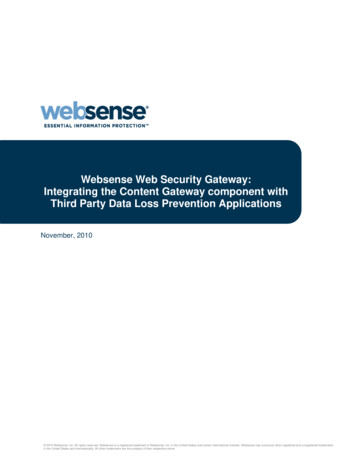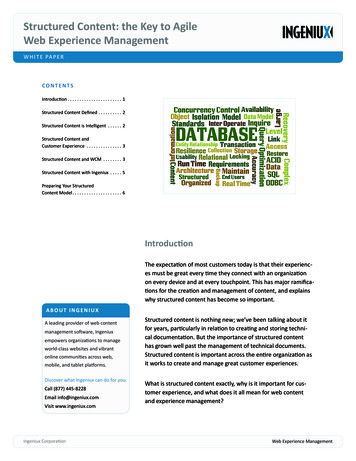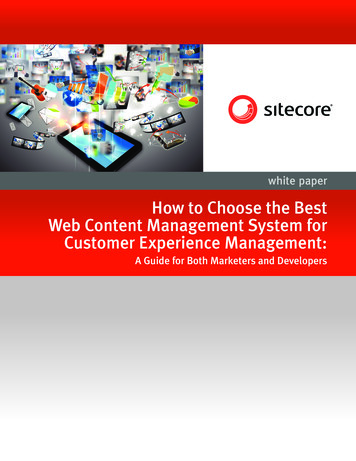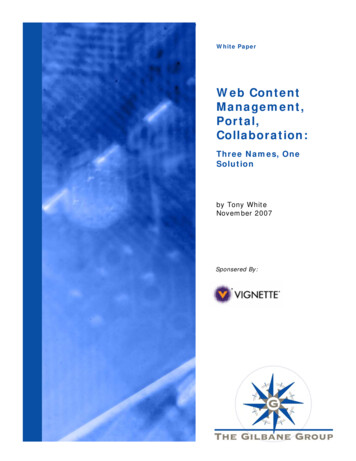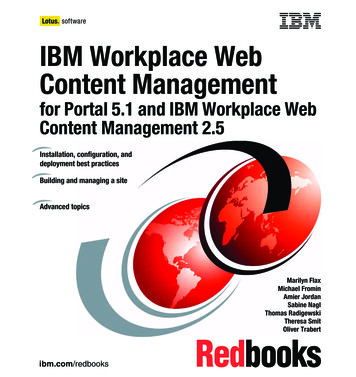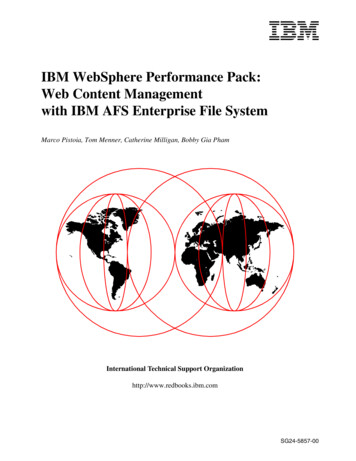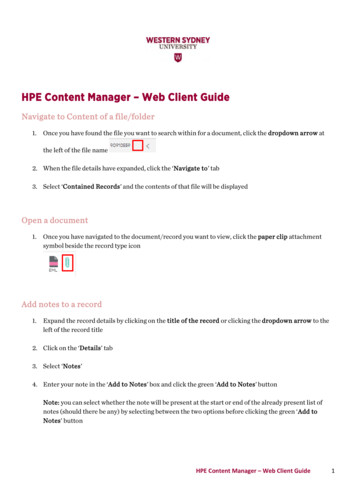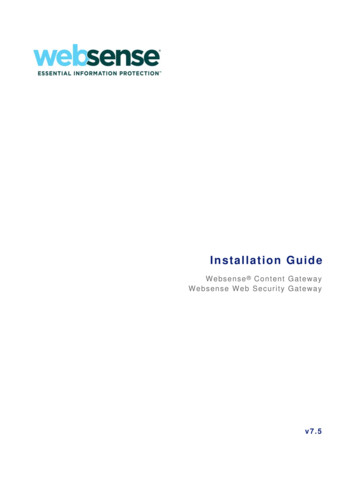
Transcription
ACL-2007 Tutorial, Prague, June 24, 2007From Web Content Mining toNatural Language ProcessingBing LiuDepartment of Computer ScienceUniversity of Illinois at Chicagohttp://www.cs.uic.edu/ liubIntroduction The Web is perhaps the single largest open datasource in the world.Web mining aims to develop new techniques toextract/mine useful knowledge from the Web.A multidisciplinary field: data mining, machine learning, natural languageprocessing, statistics, databases, informationretrieval, multimedia, etc.Due to the heterogeneity and lack of structure ofWeb data, automated mining of targeted orunexpected information is a challenging task.ACL-07 tutorial, by Bing Liu, UIC2
The Web: Opportunities & Challenges Web offers an unprecedented opportunity andchallenges to data mining and NLP, Huge amount of information, but easily accessible.Wide and diverse coverage: One can find information aboutalmost anything.Information/data of almost all types, e.g., structured tables,texts, multimedia data, etc.Semi-structured due to the nested structure of HTML code.Linked, hyperlinks among pages within a site, and acrossdifferent sites.Redundant, the same piece of information or its variantsappearing in multiple pages.ACL-07 tutorial, by Bing Liu, UIC Noisy. A Web page typically contains a mixture of manykinds of information, e.g., main contents, advertisements,navigation panels, copyright notices, etc.Surface Web and deep Web. 3Surface Web: pages that can be browsed using aWeb browser.Deep Web: databases that can only be accessedthrough parameterized query interfaces.Services. Many Web sites enable people to performoperations with input parameters, i.e., they provide services.Dynamic. Information on the Web changes constantly.Virtual society. It is not only about data, information andservices, but also about interactions among people,organizations and automated systems.ACL-07 tutorial, by Bing Liu, UIC4
Web mining (Liu, Web Data Mining book 2007) Web mining generally consists of: Web usage mining: the discovery of user accesspatterns from Web usage logs.Web structure mining: the discovery of usefulknowledge from the structure of hyperlinks.Web content mining: extraction/mining of usefulinformation or knowledge from Web pagecontents.This tutorial focuses on Web content miningand its strong connection with NLP.ACL-07 tutorial, by Bing Liu, UIC5Why NLP is so important for Web mining? Everything on the Web is for human consumption(for people to view) rather than for computersystems to process. Thus all the information (except multi-media content) isexpressed in natural language.From mining structured data, semi-structured data tomining unstructured text, NLP is everywhere.Most existing techniques are based on data mining,machine learning and IR methods.But NLP techniques are becoming increasinglynecessary.There are applications everywhere.ACL-07 tutorial, by Bing Liu, UIC6
Tutorial topics Web content mining is still a large field.This tutorial introduces the following topics: Structured data extractionInformation integrationInformation synthesisOpinion mining and summarizationAll those topics have immediate applications.7ACL-07 tutorial, by Bing Liu, UIC1. Structured Data ExtractionWrapper inductionAutomatic data extraction
Introduction A large amount of information on the Web iscontained in regularly structured data objects. Such Web data records are important: lists ofproducts and services.Applications: Gather data to provide valuedadded services often data records retrieved from databases.comparative shopping, object search (rather thanpage search), etc.Two types of pages with structured data: List pages, and detail pagesACL-07 tutorial, by Bing Liu, UIC9List Page – two lists of productsTwo listsACL-07 tutorial, by Bing Liu, UIC10
Detail Page – detailed description11ACL-07 tutorial, by Bing Liu, UICExtraction Task: an illustrationnestingimage 1 Cabinet Organizers by Copco 9-in.Round Turntable: White***** 4.95image 1 Cabinet Organizers by Copco 12-in.Round Turntable: White***** 7.95image 2 Cabinet Organizers14.75x9 Cabinet Organizer (Non-skid):White***** 7.95image 2 Cabinet Organizers22x6***** 19.95ACL-07 tutorial, by Bing Liu, UICCookware Lid Rack12
Data Model and SolutionWeb data model: Nested relations See formal definitions in (Grumbach and Mecca, ICDT-99; Liu,Web Data Mining book 2006)Solve the problem Two main types of techniques Wrapper induction – supervisedAutomatic extraction – unsupervisedInformation that can be exploited Source files (e.g., Web pages in HTML) Represented as strings or treesVisual information (e.g., rendering information)13ACL-07 tutorial, by Bing Liu, UICTree and Visual informationHTMLBODYHEADTABLEPTABLETBODYTRTR TDTD TD TD TDdatarecord 1TR TDACL-07 tutorial, by Bing Liu, UICTRTR TD TD TDTR TDTR TD TD TDTR TRTD TD TD TDTR TDdatarecord 214
Road map Wrapper Induction (supervised) Automatic data extraction (unsupervised) Given a set of manually labeled pages, amachine learning method is applied to learnextraction rules or patterns.Given only a single page with multiple datarecords, generate extraction patterns.Given a set of positive pages, generateextraction patterns.NLP connectionACL-07 tutorial, by Bing Liu, UIC15Wrapper induction Using machine learning to generate extraction rules. Many wrapper induction systems, e.g., The user marks/labels the target items in a few training pages.The system learns extraction rules from these pages.The rules are applied to extract target items from other pages.WIEN (Kushmerick et al, IJCAI-97),Softmealy (Hsu and Dung, 1998),Stalker (Muslea et al. Agents-99),BWI (Freitag and Kushmerick, AAAI-00),WL2 (Cohen et al. WWW-02),IDE (Zhai and Liu. WISE-05).We will only focus on Stalker, which also has acommercial version called Fetch.ACL-07 tutorial, by Bing Liu, UIC16
Stalker: A hierarchical wrapper inductionsystem (Muslea et al. Agents-99) Hierarchical wrapper learning Extraction is isolated at different levels of hierarchyThis is suitable for nested data records (embedded list) Each item is extracted independent of others.Manual labeling is needed for each level. Each target item is extracted using two rules A start rule for detecting the beginning of the target item.A end rule for detecting the ending of the target item.17ACL-07 tutorial, by Bing Liu, UICHierarchical extraction based on treeName: John SmithBirthday: Oct 5, 1950Cities:Chicago:(312) 378 3350(312) 755 1987PersonName Birthday List(Cities)cityList(phoneNo)New York:(212) 399 1987 Area CodeNumberTo extract each target item (a node), the wrapperneeds a rule that extracts the item from its parent.ACL-07 tutorial, by Bing Liu, UIC18
Wrapper Induction (Muslea et al., Agents-99) Using machine learning to generate extraction rules.The user marks the target items in a few training pages.The system learns extraction rules from these pages.The rules are applied to extract items from other pages. Training ExamplesE1:E2:E3:E4:513 Pico, b Venice /b , Phone 1- b 800 /b -555-151590 Colfax, b Palms /b , Phone (800) 508-1570523 1st St., b LA /b , Phone 1- b 800 /b -578-2293403 La Tijera, b Watts /b , Phone: (310) 798-0008Output Extraction Rules Start rules:R1: SkipTo(()R2: SkipTo(- b )End rules:SkipTo())SkipTo( /b )ACL-07 tutorial, by Bing Liu, UIC19Learning extraction rules Stalker uses sequential covering to learnextraction rules for each target item. In each iteration, it learns a perfect rule thatcovers as many positive examples as possiblewithout covering any negative example.Once a positive example is covered by a rule, it isremoved.The algorithm ends when all the positiveexamples are covered. The result is an orderedlist of all learned rulesACL-07 tutorial, by Bing Liu, UIC20
Some other issues in wrapper learning Active learning Wrapper verification How to automatically choose examples for the user to label(Muslea et al, AAAI-00)IDE (Zhai & Liu, WISE-05), which uses instance-basedlearning, and it is automatically active.Check whether the current wrapper still work properly(Kushmerick, 2003)Wrapper maintenance If the wrapper no longer works properly, is it possible to relabel automatically (Kushmerick AAAI-99; Lerman et al,JAIR-03)ACL-07 tutorial, by Bing Liu, UIC21Limitations of Supervised Learning Manual Labeling is labor intensive and timeconsuming, especially if one wants to extractdata from a huge number of sites.Wrapper maintenance is very costly: If Web sites change frequently.It is necessary to detect when a wrapper stops towork properly.Any change may make existing extraction rulesinvalid.Re-learning is needed, and most likely manual relabeling as well.ACL-07 tutorial, by Bing Liu, UIC22
Road map Wrapper Induction (supervised) Automatic data extraction (unsupervised) Given a set of manually labeled pages, amachine learning method is applied to learnextraction rules or patterns.Given only a single page with multiple datarecords, generate extraction patterns.Given a set of positive pages, generateextraction patterns.NLP connectionACL-07 tutorial, by Bing Liu, UIC23Automatic ExtractionThere are two main problem formulations:Problem 1: Extraction based on a single listpage (Liu et al. KDD-03; Liu, Web Data Mining book2007)Problem 2: Extraction based on multipleinput pages of the same type (list pages ordetail pages) (Grumbach and Mecca, ICDT-99). Problem 1 is more general: Algorithms for solvingProblem 1 can solve Problem 2. Thus, we only discuss Problem 1.ACL-07 tutorial, by Bing Liu, UIC24
Automatic Extraction: Problem 1Dataregion1DatarecordsDataregion2ACL-07 tutorial, by Bing Liu, UIC25Solution Techniques Identify data regions and data records By finding repeated patterns string matching (treat HTML source as a string)tree matching (treat HTML source as a tree)Align data items: Multiple alignment Many multiple alignment algorithms exist, however, they tend to make unnecessary commitments in early (can bewrong) alignments.inefficient.An new algorithm, called Partial Tree Alignment, wasproposed to deal with the problems (Zhai and Liu, WWW-05)ACL-07 tutorial, by Bing Liu, UIC26
String edit distance (definition)ACL-07 tutorial, by Bing Liu, UIC27Tree matching There are many definitions of tree matching andtree edit distances. E.g., Here we only briefly discuss a restricted treematching algorithm, called Simple Tree Matching(Yang, 1991), which is quite effective for dataextraction No node replacement and no level crossing are allowed.Dynamic programming solutionACL-07 tutorial, by Bing Liu, UIC28
Simple tree matching(Yang 1991; Liu, Web Data Mining book 2007) Let A RA:〈A1, , Ak〉 and B RB:〈B1, , Bn〉 betwo trees, Let W(A, B) be the number of pairs in the maximummatching of trees A and B.If RA and RB contain identical symbols, thenW(A, B)) m(〈A1, ,Ak〉, 〈B1, , Bn〉) 1, where RA and RB are the roots of A and B, and Ai andBj are their i-th and j-th first-level subtreeswhere m(〈A1, , Ak〉, 〈B1, , Bn〉) is the number of pairs inthe maximum matching of 〈A1, , Ak〉 and 〈B1, , Bn〉.If RA RB, W(A, B) 0.ACL-07 tutorial, by Bing Liu, UIC29Simple tree match formulation(Liu, Web Data Mining Book 2007) A dynamic programming formulationACL-07 tutorial, by Bing Liu, UIC30
Multiple alignment Pairwise alignment/matching is not sufficientbecause a web page usually contain morethan one data record.We need multiple alignment.Optimal alignment/matching is exponential.We discuss two techniques Center Star methodPartial tree alignment.31ACL-07 tutorial, by Bing Liu, UICCenter star method A simple & classic technique. Often used for multiplestring alignments, but can be adopted for trees.Let the set of strings to be aligned be S. In themethod, a string sc that minimizes, si Sd ( sc , si )is first selected as the center string. d(sc, si) is thedistance of two strings. O(k2n2) pair-wise matches.The algorithm then iteratively computes the alignmentof rest of the strings with sc.ACL-07 tutorial, by Bing Liu, UIC32
Partial tree alignment (Zhai and Liu, WWW-05) Choose a seed tree: A seed tree, denoted by Ts, ispicked with the maximum number of data items.The seed tree is similar to center string, but withoutthe O(k2n2) pair-wise tree matching to choose it.Tree matching:For each unmatched tree Ti (i s), match Ts and Ti.Each pair of matched nodes are linked (aligned).For each unmatched node nj in Ti do expand Ts by inserting nj into Ts if a position for insertioncan be uniquely determined in Ts.The expanded seed tree Ts is then used insubsequent matching.33ACL-07 tutorial, by Bing Liu, UICPartial tree alignment of two treesTsaTipbeadcbNew part of TspInsertion is possiblepbcInsertion is notpossibleACL-07 tutorial, by Bing Liu, UICeedTspabTieapxe34
More information More information, IEPAD (Chang and Lui, WWW-01)MDR (Liu et al. KDD-03)DeLa (Wang and Lochovsky, WWW-03)Lerman et al (SIGMOD-04)DEPTA (Zhai and Liu, WWW-2005)NET (Liu and Zhai WISE-2005)(Zhao et al, WWW-05)(Liu, Web Data Mining book, 2007) containsformulations, algorithms and more ACL-07 tutorial, by Bing Liu, UIC35Road map Wrapper Induction (supervised) Automatic data extraction (unsupervised) Given a set of manually labeled pages, amachine learning method is applied to learnextraction rules or patterns.Given only a single page with multiple datarecords, generate extraction patterns.Given a set of positive pages, generateextraction patterns.NLP connectionACL-07 tutorial, by Bing Liu, UIC36
The RoadRunner System(Crescenzi et al. VLDB-01)Given a set of positive examples (multiple samplepages). Each contains one or more data records. From these pages, generate a wrapper as a unionfree regular expression (i.e., no disjunction).The approach To start, a sample page is taken as the wrapper. The wrapper is then refined by solving mismatchesbetween the wrapper and each sample page, whichgeneralizes the wrapper. A mismatch occurs when some token in the sample doesnot match the grammar of the wrapper.ACL-07 tutorial, by Bing Liu, UIC37ACL-07 tutorial, by Bing Liu, UIC38
The EXALG System(Arasu and Garcia-Molina, SIGMOD-03) The same setting as for RoadRunner: need multipleinput pages of the same template.The approach:Step 1: find sets of tokens (called equivalence classes)having the same frequency of occurrence in everypage.Step 2: expand the sets by differentiating “roles” oftokens using contexts. Same token in differentcontexts are treated as different tokens.Step 3: build the page template using the equivalenceclasses based on what is in between twoconsecutive tokens, empty, data or list.ACL-07 tutorial, by Bing Liu, UIC39Road map Wrapper Induction (supervised) Automatic data extraction (unsupervised) Given a set of manually labeled pages, amachine learning method is applied to learnextraction rules or patterns.Given only a single page with multiple datarecords, generate extraction patterns.Given a set of positive pages, generateextraction patterns.NLP connectionACL-07 tutorial, by Bing Liu, UIC40
Where is NLP? Two places Item matching based on text.Integration of data from multiple sites.Regarding structured data, the key differencebetween those on the Web and those inrelational databases is that Web uses natural language: It is for general publicto view. Few abbreviations or acronyms .Databases may not: Abbreviations or acronyms arewidely used.ACL-07 tutorial, by Bing Liu, UIC41Content item matching In tree matching, it is possible that multiple matchescan give the same maximum score: Which is right?For example, node c in tree A can match either thefirst or the last node c in tree B.Current method: Word match, but not enough “Ship in 24 hours” ? “Overnight delivery”ACL-07 tutorial, by Bing Liu, UIC42
Integration of data from multiple sites In a real application, one needs to extract data frommultiple sources and put them into databases. Thisintroduces three problems. Column match: match columns in different data tables thatcontain the same type of information (e.g., product names)Value match: match values that are semantically identicalbut represented differently in different Web sites. E.g., “Coke” and “Coca Cola”, “authors” and “writers”).Labeling: Give a natural language label or attribute name toeach column.Very hard problems! This leads to our next topic.ACL-07 tutorial, by Bing Liu, UIC2. Information Integration43
Introduction At the end of last topic, we identified the problem ofintegrating extracted data: column match and instance value match.Unfortunately, limited research has been done inthis specific context.Much of the Web information integration researchhas been focused on the integration of Web queryinterfaces.In this part, we introduce some basic integration techniques, andWeb query interface integrationACL-07 tutorial, by Bing Liu, UIC45Road map Basic integration techniques Web query interface integration Schema matching problemDifferent approachesThe problemSome techniquesNLP connectionACL-07 tutorial, by Bing Liu, UIC46
Database integration (Rahm and Berstein, 2001) Information integration started with databaseintegration, which has been studied in thedatabase community since the early 1980s.Fundamental problem: schema matching,which takes two (or more) database schemasto produce a mapping between elements (orattributes) of the two (or more) schemas thatcorrespond semantically to each other.Objective: merge the schemas into a singleglobal schema.47ACL-07 tutorial, by Bing Liu, UICIntegrating two schemas Consider two schemas, S1 and S2,representing two customer relations, Custand ameACL-07 tutorial, by Bing Liu, UICCustIDCompanyContactPhone48
Integrating two schemas (contd) Represent the mapping with a similarityrelation, , over the power sets of S1 and S2,where each pair in represents one elementof the mapping. E.g.,Cust.CNo Customer.CustIDCust.CompName Customer.Company{Cust.FirstName, Cust.LastName} Customer.ContactACL-07 tutorial, by Bing Liu, UIC49Different types of matching Schema-level only matching: only schemainformation is considered.Domain and instance-level only matching:some instance data (data records) andpossibly the domain of each attribute areused. This case is quite common on the Web.Integrated matching of schema, domain andinstance data: Both schema and instancedata (possibly domain information) areavailable.ACL-07 tutorial, by Bing Liu, UIC50
Road map Basic integration techniques Web query interface integration Schema matching problemDifferent approachesThe problemSome techniquesNLP connectionACL-07 tutorial, by Bing Liu, UIC51Pre-processing for integration (He and ChangSIGMOG-03, Madhavan et al. VLDB-01, Wu et al. SIGMOD-04) Tokenization: break an item into atomic words usinga dictionary, e.g., Expansion: expand abbreviations and acronyms totheir full words, e.g., Break “fromCity” into “from” and “city”Break “first-name” into “first” and “name”From “dept” to “departure”Stopword removal and stemmingStandardization of words: Irregular words arestandardized to a single form, e.g., From “colour” to “color”ACL-07 tutorial, by Bing Liu, UIC52
Schema-level matching (Rahm and Berstein, 2001) Schema level matching relies on informationsuch as name, description, data type,relationship type (e.g., part-of, is-a, etc),constraints, etc.Match cardinality: 1:1 match: one element in one schema matchesone element of another schema.1:m match: one element in one schema matchesm elements of another schema.m:n match: m elements in one schema matches nelements of another schema.ACL-07 tutorial, by Bing Liu, UIC53An example m:1 match is similar to 1:m match. m:n matchis complex, and there is little work on it.ACL-07 tutorial, by Bing Liu, UIC54
Linguistic approaches (See (Liu, Web Data Miningbook 2007) for many references) They are used to derive mat
ACL-07 tutorial, by Bing Liu, UIC 5 Web mining (Liu, Web Data Mining book 2007) Web mining generally consists of: Web usage mining: the discovery of user access patterns from Web usage logs. Web structure mining: the discovery of useful knowledge from the structure of hyperlinks. Web content mining: extractio
